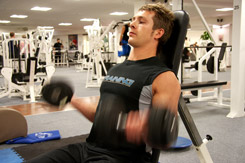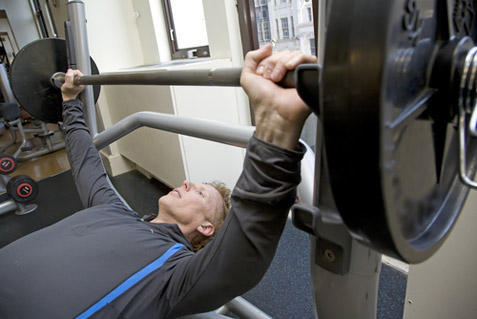
Originally published: 07/04/2000
Updated: 05/13/2010
Furci Home / Fitness Channel / Bullz-Eye Home
How many sets should you perform per exercise? 5, 4, 3, 2 or 1? How many repetitions should you perform for each set? 12, 10, 8, 5 or 2? The answer is: all of the above. However, many self-proclaimed experts would lead you to believe that there is only one perfect training program. Others would like you to believe that there is no need to plan workouts, and that you should train instinctively. Although we are basically the same physiologically, we react differently to different training stimulus. Some of us recover very quickly and can use a high volume of training. Some of us recover slowly and need to use a low volume approach. It is our inherent differences that make designing programs such a challenge.
There are two problems coaches are confronted with when designing programs. No matter how meticulously and carefully you design the program, it may not work for everybody. This is the first problem. Secondly, when a program does work, it will only work for so long. Knowing when and how to change your program is key.
 When I design programs, I use 6 to 9 week cycles that are divided into three components. I evaluate the person's goals and their weaknesses, and make adjustments accordingly. For instance, a person who wants to increase their strength in the squat, but has weak hams and glutes, needs a program designed accordingly. The leg portion of the workout will be designed around exercises that strengthen the posterior chain (hamstrings, glutes and low back). At the end of the cycle, I evaluate the program's effectiveness and determine the next course of action. Likewise, you should always evaluate your progress. What are your strengths and weaknesses? Are you moving toward your goal?
When I design programs, I use 6 to 9 week cycles that are divided into three components. I evaluate the person's goals and their weaknesses, and make adjustments accordingly. For instance, a person who wants to increase their strength in the squat, but has weak hams and glutes, needs a program designed accordingly. The leg portion of the workout will be designed around exercises that strengthen the posterior chain (hamstrings, glutes and low back). At the end of the cycle, I evaluate the program's effectiveness and determine the next course of action. Likewise, you should always evaluate your progress. What are your strengths and weaknesses? Are you moving toward your goal?
So where do you start? First of all, always keep in mind that your overall goal should be to get stronger. You should not go to the gym if you're not committed to making progress. I know you're asking yourself; "How can I get stronger every time I go to the gym?" Believe me -- if you cycle your workouts correctly, you'll make progress every time.
Program Design Continued
How many reps?
There is no right answer to the number of repetitions required to optimize performance. However, there are a few general principles that you can follow that are based upon scientific research and mounds of empirical data.
Strength should always be your goal. I can't stress this enough. The heavier the weight lifted, the greater the muscle tension. The higher the level of muscle tension put on the muscle, the greater the response. But, like I always tell many of my clients, "Leave your ego at the door." Strength is relative. What might be heavy for one may be light for somebody else. Do not compare yourself to others. Compete against yourself on a daily, weekly, monthly and even yearly basis.
Strength researchers have found that when performing between 1 and 5 repetitions, you'll increase strength with minimal gains in muscle size. This type of training is optimal for somebody who competes within a weight class like a wrestler or a power lifter. Most of these individuals do not want to gain weight, but need to increase their relative strength. Six to 12 reps, however, will increase strength through developing larger muscles. In other words, the best rep range to gain muscle and strength is 6 to 12. Or is it?
 Actually it's the combination of the two that produce the best overall gains. If gaining muscle mass is your goal, then roughly 20 to 30 percent of your program should be comprised of repsn the 1 to 5 range. The remaining 70 to 80 percent should be performed in the 6 to 12 range. The benefit of incorporating low reps in your program is that you'll be stronger when you finish your cycle. The stronger you are, the more weight you'll use when performing higher reps. The more weight you use, the higher the muscle tension. The higher the muscle tension -- you know the rest.
Actually it's the combination of the two that produce the best overall gains. If gaining muscle mass is your goal, then roughly 20 to 30 percent of your program should be comprised of repsn the 1 to 5 range. The remaining 70 to 80 percent should be performed in the 6 to 12 range. The benefit of incorporating low reps in your program is that you'll be stronger when you finish your cycle. The stronger you are, the more weight you'll use when performing higher reps. The more weight you use, the higher the muscle tension. The higher the muscle tension -- you know the rest.
For the vast majority of you reading this, have no fear, training with relatively extremely heavy weight performing 1 to5 reps is not a prerequisite to make gains. In fact, I would never recommend it for beginners, intermediates or people who are just looking to get into shape. It makes no sense for a 40-something-year-old man like myself to perform maximum weight with low repetitions. Likewise, I would never encourage a female who is interested in losing body fat and gaining strength to perform a maximum squat for 3 reps.
How many sets?
This is another frequently asked question. First, I need to define a set. A set is a group of consecutive repetitions. There are several types of sets, most which are of no concern at this time. If you are reading this, then you are obviously interested in physically improving yourself, and that is exactly what you are going to get. Just remember, the quality of the set is much more important than the type of set. If you're not willing to give 100 percent effort, it doesn't matter what type of set you perform, your gains will be sub par.
Outside of the detailed workout given later, the following factors will help you determine how many sets you need to start with and how to change if needed. Although important, do not read into the following -- these factors are not the end-all-be-all. The most important factor in determining the number of sets you need to perform will be your recovery ability.
LEVEL OF FITNESS
I will always prescribe fewer sets, 1 to 2 working sets per exercise. And this is where the majority of people will stay. As the average person advances, rather than adding sets to existing exercises, I have found it more productive to ad an exercise.
 There is a small percentage of intermediate or advanced trainees who can perform up to 4 sets per exercise. However, this is not the norm. The average person can not recover from doing 3, 4 or 5 working sets per exercise. And as most of you will see, recovering from one all-out set per exercise will be tough. Again, as you'll read over and over, recovery ability will be the determining factor. If you're training correctly, and not recovering, you're doing too much.
There is a small percentage of intermediate or advanced trainees who can perform up to 4 sets per exercise. However, this is not the norm. The average person can not recover from doing 3, 4 or 5 working sets per exercise. And as most of you will see, recovering from one all-out set per exercise will be tough. Again, as you'll read over and over, recovery ability will be the determining factor. If you're training correctly, and not recovering, you're doing too much.
EXPERIENCE
As a general rule, the longer one has been training, the stronger they are. The more weight one lifts, the more taxing it is on the muscles and nerves involved. Hence, the stronger a person gets the fewer sets they can recover from. If a plateau is reached, a decrease in the amount of work being performed or another day off is essential especially for an experienced lifter.
RECOVERY ABILITY
We all recover from exercise at different rates. Many people who recover quickly have reached a high level of success performing a high number of sets. Many who recover slowly have also been very successful performing low numbers of sets. Because everyone is unique in their ability to adapt and recover from different programs, the number of sets needs to be individualized. Without keeping a detailed journal, it will be impossible to determine what workouts were successful and which ones were not.
NUMBER OF EXERCISES
The more exercises you perform, the fewer sets you need, despite your fitness ability. The optimum amount of time you should be training is between 45 and 60 minutes. Hormone levels start to change for the worse after about an hour of training. This does not include warming up. Not only do your testosterone and growth hormone levels decrease, but your cortisol levels rise. Cortisol is a catabolic (muscle wasting) compound that we naturally secrete as a result of stress. Training over an hour puts you in the best environment for destroying muscle. So if you add exercises but do not decrease the number of sets to keep you in that timeframe, you're going to have a very hard time making gains.
Lift the weight, don't throw it
There is one component of weight training that is commonly overlooked: tempo. It is widely accepted among personal trainers, bodybuilders and strength athletes, that one should lift weights under control. Yet most of them haven't a clue as to what that really means, or how it can affect their training.
Tempo is a seldom used tool by most people who weight train, mainly out of ignorance, but for some it's ego. Because tempo forces one to lift the weight under control, which compels the targeted muscles to do the work, one needs to decrease the amount of weight or reps used when it's employed.

Tempo is, very simply, the speed of your reps. It is expressed and recorded as a four digit number representing the seconds required to complete a rep. Example: 50X0 (five, zero, explosive, zero). Using the bench press, the first digit is the speed in which the weight is lowered (negative or eccentric). The second digit is the amount of time one pauses once they've reached the chest. The third digit is the amount of time one takes to raise the weight (positive or concentric). If an "X" is used for the third digit, it means explosive, or as fast as possible. The forth digit, if used, is the amount of time one takes before lowering the weight again.
Is it really necessary to count each rep in order to build strength and muscle? No. Is it necessary to lift under control and to vary your speeds to get the best, most rapid gains per your genetics? Yes. When you perform an exercise under control, the muscles are truly doing the work. "Slower," not "slow" speeds make the muscles work harder by eliminating momentum and bouncing. There's nothing impressive about performing a bench press by allowing the weight to drop, bounce off your chest and then barely being able to complete the lift.
How do you know if you're lifting under control? I can guarantee that 9 out of 10 of you reading this don't. A simple test you can perform is to use a 3010 tempo while performing 5 reps benching a moderate weight. Count one, one thousand; two, one thousand; three, one thousand, on the eccentric portion of the lift. Do not pause at the bottom. Then, on the concentric portion lift count one, one thousand. Does this seem slow to you? If you are like most, it probably does. Continue to use a 3010 tempo until you start to feel comfortable with what "under control" feels like.
Under control, slower speed training, especially the eccentric portion of the lifts, should comprise most of your training. But just as you need to vary your reps, varying your speeds will also elicit a greater effect.
Don't miss Part I and Part III of "A No-Nonsense Guide to Design Your Workouts."
You can follow us on Twitter and Facebook for content updates. Also, sign up for our email list for weekly updates and check us out on Google+ as well.













